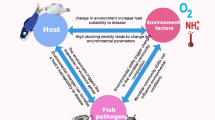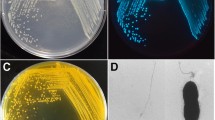Abstract
A total of 180 bacteriophages active against 37 of 55 psychrophilic bacteria (isolated from fish and other sources) were isolated from sea water, sewage, and fish fillets. Cross-infection tests made with pools of homologous phages indicated that only 8 strains were resistant to all the phages.
Some similarities between marine and terrestrial pseudomonads were found, as well as significant differences between species previously considered to be closely related.
Similar content being viewed by others
References
Adams, M. H. 1959. Bacteriophages. - Interscience Publishers, New York.
DeLey, J. 1964.Pseudomonas and related genera. - Ann. Rev. Microbiol.18: 17–46.
Delisle, A. L. andLevin, R. E. 1969. Bacteriophages of psychrophilic pseudomonads. II. Host range of phage active againstP. putrefaciens. - Antonie van Leeuwenhoek35: 318–324.
Holloway, B. W. 1965. Variations in restriction and modification of bacteriophage following increase of growth temperature ofPseudomonas aeruginosa. - Virology25: 634–642.
Hugh, R. andLeifson, E. 1953. The taxonomic significance of fermentative versus oxidative metabolism of carbohydrates by various gram negative bacteria. - J. Bacteriol.66: 24–26.
Ingram, M. andShewan, J. M. 1960. Introductory reflections on thePseudomonas-Achromobacter group. - J. Appl. Bacteriol.23: 373–378.
Klinge, K. 1959.Pseudomonas fluorescens, ein Boden- und Wasserkeim. III. Identifizierung vonP. fluorescens-Stämmen durch Bakteriophagen. - Arch. Mikrobiol.34: 270–284.
Kovacs, N. 1956. Identification ofPseudomonas pyocyanea by the oxidase reaction. - Nature178: 703.
Levin, R. E. 1968. Detection and incidence of specific spoilage bacteria in fish. I Methodology. - Appl. Microbiol16: 1734–1737.
Lysenko, O. 1961.Pseudomonas - An attempt at a general classification - J. Gen. Microbiol.25: 379–408.
Rhodes, M. E. 1959. The characterization ofPseudomonas fluorescens. - J. Gen. Microbiol.21: 221–263.
Shewan, J. M., Hobbs, G. andHodgkiss, W. 1960. A determinative scheme for the indentification of certain genera of gram-negative bacteria, with special reference to the Pseudomonadaceae. - J. Appl. Bacteriol.23: 379–390.
Stanier, R. Y., Palleroni, N. J. andDoudoroff, M. 1966. The aerobic pseudomonads: A taxonomic study. - J. Gen. Microbiol.43: 159–271.
Stolp, H. 1961. Neue Erkentnisse über phytopathogene Bakterien und die von ihnen verursachten Krankheiten. I. Verwandschaftsbeziehungen zwischen phytopathogenenPseudomonas-„Arten“ und saprophytischen Fluoreszenten auf der Grundlage von Phagenreaktionen. - Phytopathol. Z.42: 197–262.
Author information
Authors and Affiliations
Additional information
The present work represents part of a dissertation submitted by the senior author in partial fulfillment of the requirements for the Ph.D. degree at the University of Massachusetts.
This investigation was supported by Public Health Service grant EF-00873-2 from the Division of Environment Engineering and Food Protection.
Rights and permissions
About this article
Cite this article
Delisle, A.L., Levin, R.E. Bacteriophages of psychrophilic pseudomonads. I. Host range of phage pools active against fish spoilage and fish-pathogenic pseudomonads. Antonie van Leeuwenhoek 35, 307–317 (1969). https://doi.org/10.1007/BF02219151
Received:
Issue Date:
DOI: https://doi.org/10.1007/BF02219151




